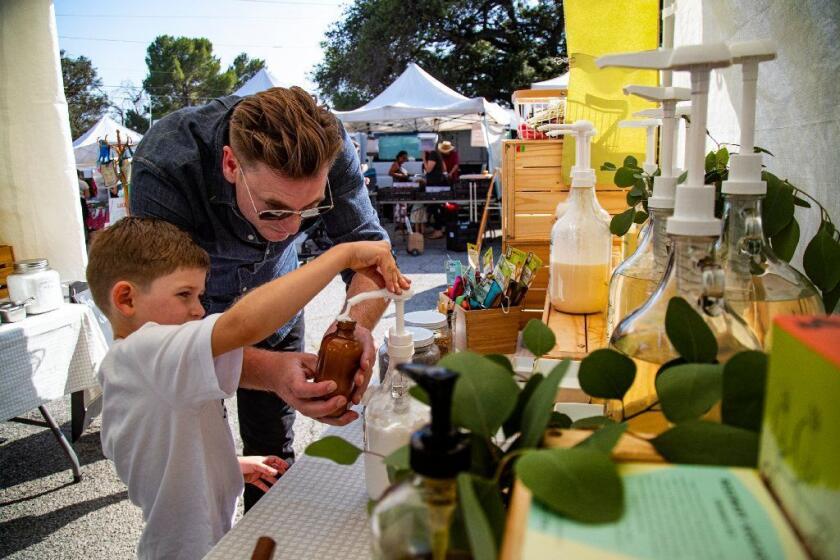Is your yoga mat bad for the environment?
- Share via
Eco-conscious yogis may diligently bring muslin totes with them to the grocery store, unfailing refill their BPA-free water bottles when working out, and religiously keep their showers short to help conserve the earth’s water supply. But some might be completely unaware of the environmental disaster right under their downward-facing-dog noses: yoga mats.
“I think of the years practicing on disgusting PVC-based mats, chemicals rubbing into my skin, and the thousands of years the mat will live afterwards in landfills and, just ugh, it gives me hives thinking about it,” said Schuyler Grant, national director of yoga for the Wanderlust Festival, an online yoga community, which also has a brick-and-mortar studio in Hollywood.
The culprit? Many yoga mats contain polyvinyl chloride (PVC), which many environmental experts believe is a highly toxic plastic.
David Procyshyn, founder of DoYogaWithMe.com, which offers free online yoga sessions, recently started adding content to the group’s website challenging the industry to shift toward more sustainable practices, asking: “Can You Practice Without Plastic?” The site has posted articles on the environmental impact of yoga mats and clothing as well as the environmentalism implicit in yogic philosophy. However, even eco-savvy practitioners get blindsided. “It was only a few months ago that my wife and I realized she had been practicing on a PVC mat for more than a decade,” he wrote in a recent email.
The yoga industry has begun to take on the issue of plastic, offering a dizzying number of products and programs designed to help mat buyers become more ethical consumers. Click on a yoga mat site and there is a bombardment of Earth-friendly bona fides: green, sustainable, eco-friendly. However, there is no sheriff in town setting standards or regulations, leaving “eco-friendly” pretty much a self-defining term.
“There is a lack of regulation; yogis need to research what brands are saying, what the mat is made of and how it is disposed of,” said James Armitage, founder and chief executive of Liforme, an online retailer of yoga gear. “It is like any consumer product, channeled through the lens of yoga mats.”
Liforme was one of the pacesetters for eco-awareness in the industry. The company spent five years in a development stage working with engineers, scientists and yoga teachers to produce non-PVC, naturally sourced sustainable rubber mats that provide grip and are biodegradable, according to Armitage. The mats, introduced in 2013, are shipped in fully recyclable packaging — no plastic.
Yoga Design Lab uses bales of plastic bottle waste made from polyethylene terephthalate (PET) that have been supplied by recycling collectors and then eventually (after a mind-numbing number of steps) transformed into mats. “We tested many different materials and found recycled PET to be an excellent upcycling of plastic bottles — absorbent, durable and perfect for our designer printed mats,” explained Karina van den Heever, the marketing and press coordinator for the company. (The company also makes yoga mats out of biodegradable natural tree rubber.)
Jasper and Vjera Watts, along with their two young children, are trying to live a plastic-free life. It isn’t easy.
The very chic Manduka brand (Lady Gaga was once photographed carrying a black Manduka mat) launched a recycling program on Earth Day 2018. The program has evolved to allow any purchasers of their mat to send back their used mats to be recycled, including non-Manduka mats. The Los Angeles-based Manduka works with the Renewal Workshop, which cleans, sorts, donates, upcycles and recycles the mats. (Manduka’s mats are available for rental at many studios, including Wanderlust Hollywood and The Green Yogi in Manhattan Beach.)
A more radical departure is yoga mats made from cork. Cork mats do not look like traditional mats, and yogis may find they have a different feel. Corc Yoga, started in 2018, makes its mats from cork harvested in Portugal; the tree is shaved, and the bark can grow back. The company just started a rent-a-mat program through which cork-curious yogis can try out the mat.
Yoga companies are also trying to be eco-friendly in ways other than mat materials. JadeYoga mats plants a tree for every mat sold — a number prominently displayed on its website clocks in at more than 1.5 million trees. “I joined our family business already making pads for area rugs made out of natural rubber, so it was a short trip to eco-friendly mats,” president Dean Jerrehian, a former environmental lawyer, wrote in an email. “Jade mats are made sustainably with natural rubber tapped from rubber trees, a rapidly renewable resource.”
Being environmentally aware does not come cheap. Amazon offers mats from $15 compared with $70
and up for an eco-friendly mat. “It’s a truism: You get what you pay for. Cheaper is more toxic,” said Armitage of Liforme.
Ned Monroe, president and chief executive officer of the Vinyl Institute, in a statement issued after the online version of this article was published, disputed the contention made by some yoga mat manufacturers that PVC is harmful to the environment. “PVC is an inert material which has been rigorously studied for decades,” said Mr. Monroe. “It has been used safely in consumer and commercial products for more than 50 years. PVC yoga mats are durable, safe, easy to clean and affordable for users.”
Then there is another way to go. Elizabeth Royte is a Brooklyn-based environmental journalist whose books include “Bottlemania: How Water Went on Sale and Why We Bought It” and “Garbage Land: On the Secret Trail of Trash.” Royte’s general green shopping rule is to buy less stuff, share what’s already out there, and if you do buy, look at Craigslist. Her caution is to always think about what kind of waste something is going to make before you buy it.
“Will your yoga mat be toxic in landfill?” she said. “I have an old yoga mat that is starting to crumple. It’s probably adding microplastics to my house and to Prospect Park when I do yoga in the park. But I’m loath to give it up. I think I will use it until it’s lace-like.”
More to Read
Sign up for The Wild
We’ll help you find the best places to hike, bike and run, as well as the perfect silent spots for meditation and yoga.
You may occasionally receive promotional content from the Los Angeles Times.











